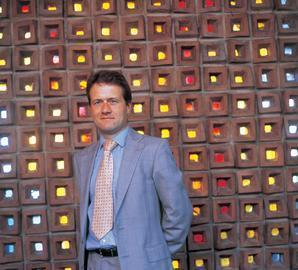Profile in association with Durapipe
The bust depicting Simon O'Hea's grandfather that adorns the reception of Colt's UK headquarters must serve as a daily reminder for the current O'Hea of the traditions on which the company has been built. They are traditions of which O'Hea is rightly proud. "We've got a strong record of innovation going right the way back to the 1930s when my grandfather was involved with the marketing of more than 50 different innovations, including the Colt Cowl and Colt timber houses." New product development remains a key element of the company's strategy today.
New product development and business planning are the areas that O'Hea is responsible for. He joined the family business after a degree in Classics at Oxford. Not the usual route for someone involved in the construction industry, but one that O'Hea feels equipped him well for his role. "Studying languages has been immensely helpful for improving my communication skills, in particular with the co-ordination with the German-speaking region which is important to Colt."
With a strong foothold in Northern Europe, Colt is now looking to grow its activities in other regions. "We are looking to build on our position in France and Iberia," says O'Hea.
The new European Union member states, as well as Australia, Russia and China are also expected to provide solid opportunities for growth. "There is growing interest in these countries in the products and services we offer, particularly in smoke control," he says.
O'Hea combines his role at Colt with the position of chairman of BSRIA, which he has held since last November. "Colt has had a very close association with BSRIA for many years and we have always thought of it as a great organisation supporting the industry, run for the benefit of its members, with clear aims and objectives, providing a wide range of services as well as knowledge based research."
O'Hea is well aware of the challenges faced by BSRIA and other research associations, but he believes their function is crucial to the future of the industry. "I think the connection between innovation and the tightening of regulations is very strong. If the government is going to deliver on its energy targets it needs to know how to achieve that. Innovation relating to buildings and particularly building services is of prime importance. This is where BSRIA and other research associations and universities have got a major role to play."
With that in mind, would it not make more sense for the government to offer more support to these establishments? "There are lots of competing needs for funding," he says. "On the supply side, the split of the government bodies into DEFRA, DTI and the regional development authorities and ODPM has made the commitment to funding more haphazard. There is a wealth of initiatives competing for less and less cash.
“While the increased funding by the DTI for innovation is to be welcomed, little of it is going to technologies of relevance to construction. It's hard to convince people that there is much research into construction related activity to advance the case of UK plc."
BSRIA is investigating ways to involve more manufacturers in its activities, recognising that they have the skills that can make the difference. However from a manufacturer's point of view, O'Hea also understands that many companies are reluctant to outsource much of their r&d. "Manufacturers generally like to carry out their own testing, product certification and market research, to keep all in house. At Colt, we're trying to see how our skills base
matches BSRIA's and how r&d projects could be partly outsourced to BSRIA. We have previously outsourced some of our market assessments.
"Equally the Association is trying get more participation of member companies in the research process. With the reduction in government funding, the Association is trying to find new projects that are of interest to industrial partners and to provide real added value services to manufacturers.”
O’Hea says that BSRIA is shifing to a more one-on-one account management approach. “We’re talking to our partners on a more individual level about their research and informational needs so that we can adjust what we deliver accordingly.”
As far as the future for research associations is concerned, O’Hea feels that BSIRA are learning to adapt to the changing funding landscape and react to what their customers want. “It’s about entering into a dialogue with the wider group and undertsanding their needs and then finding the resources to convert those needs into projects.”
Source
Building Sustainable Design





















No comments yet